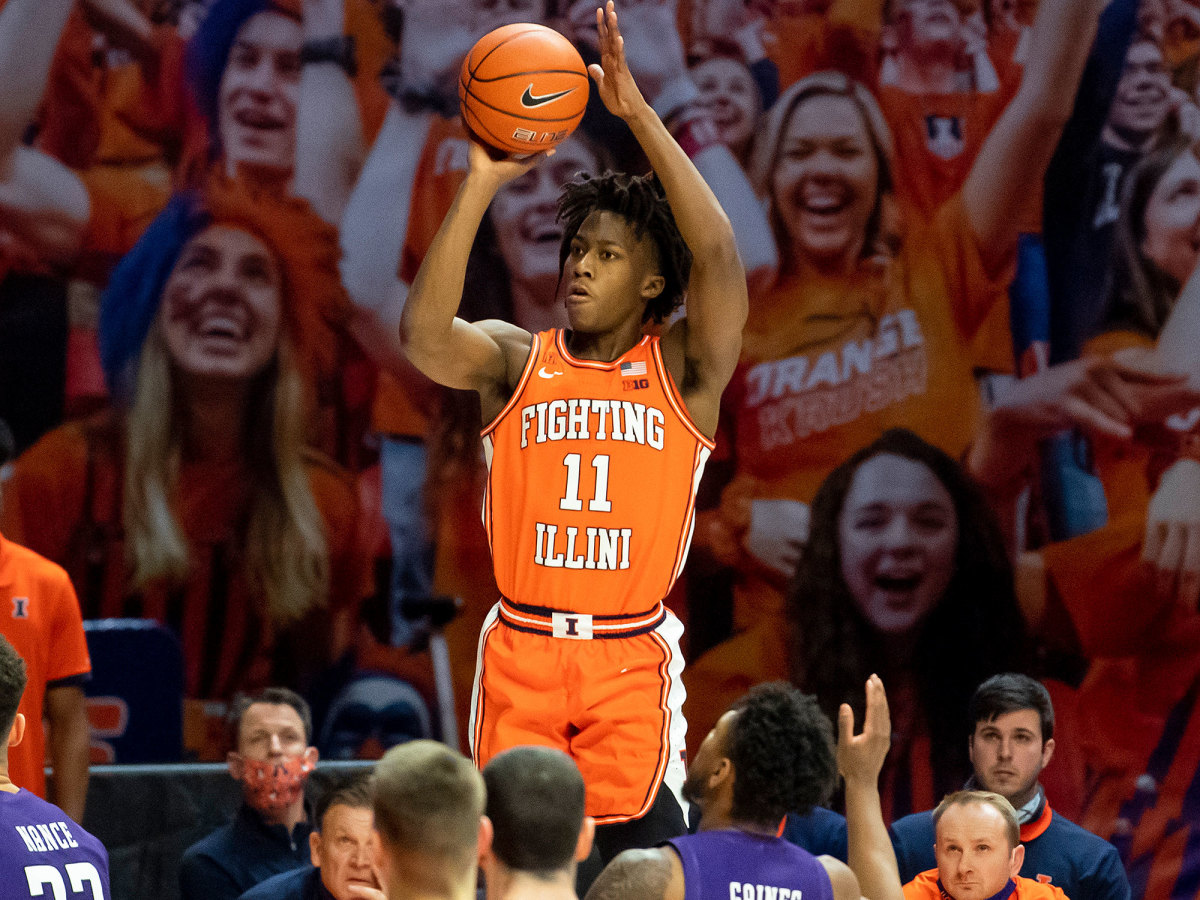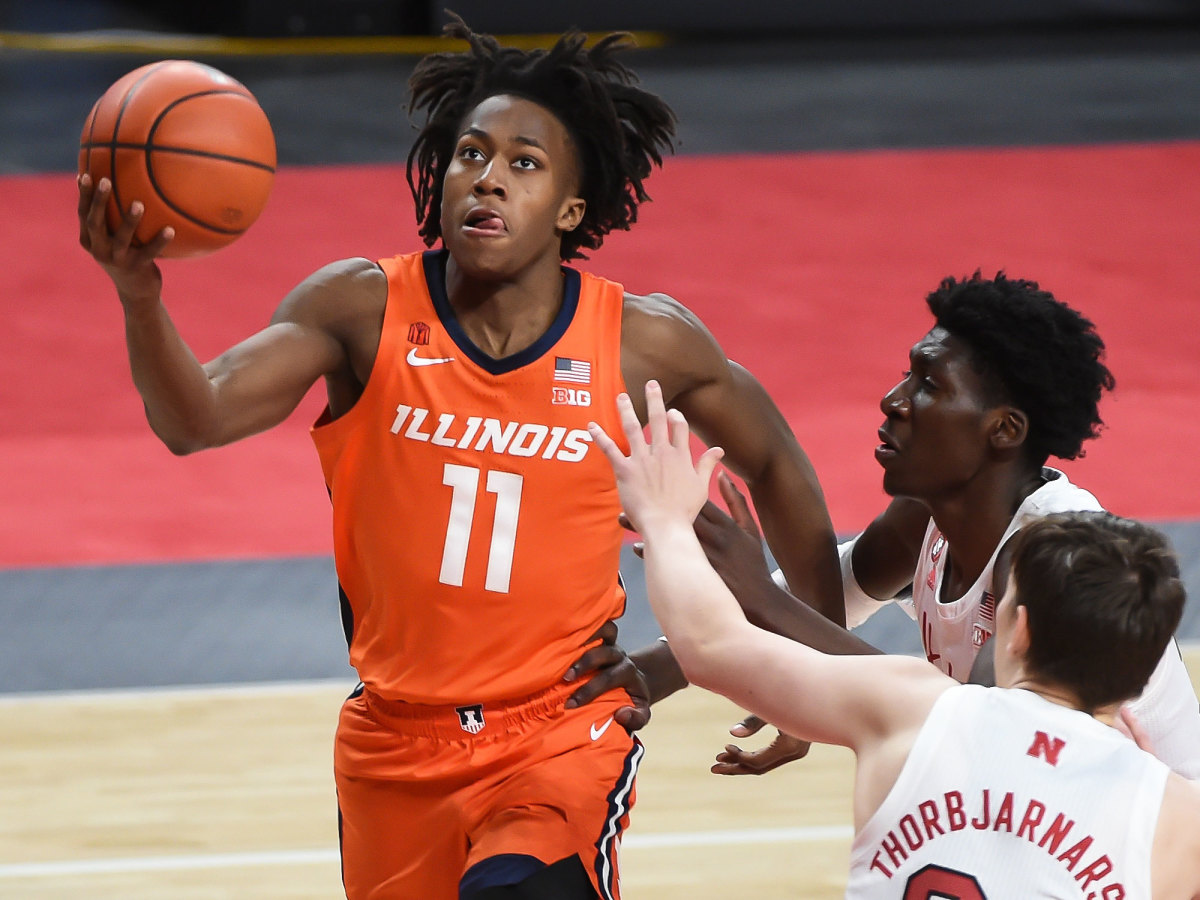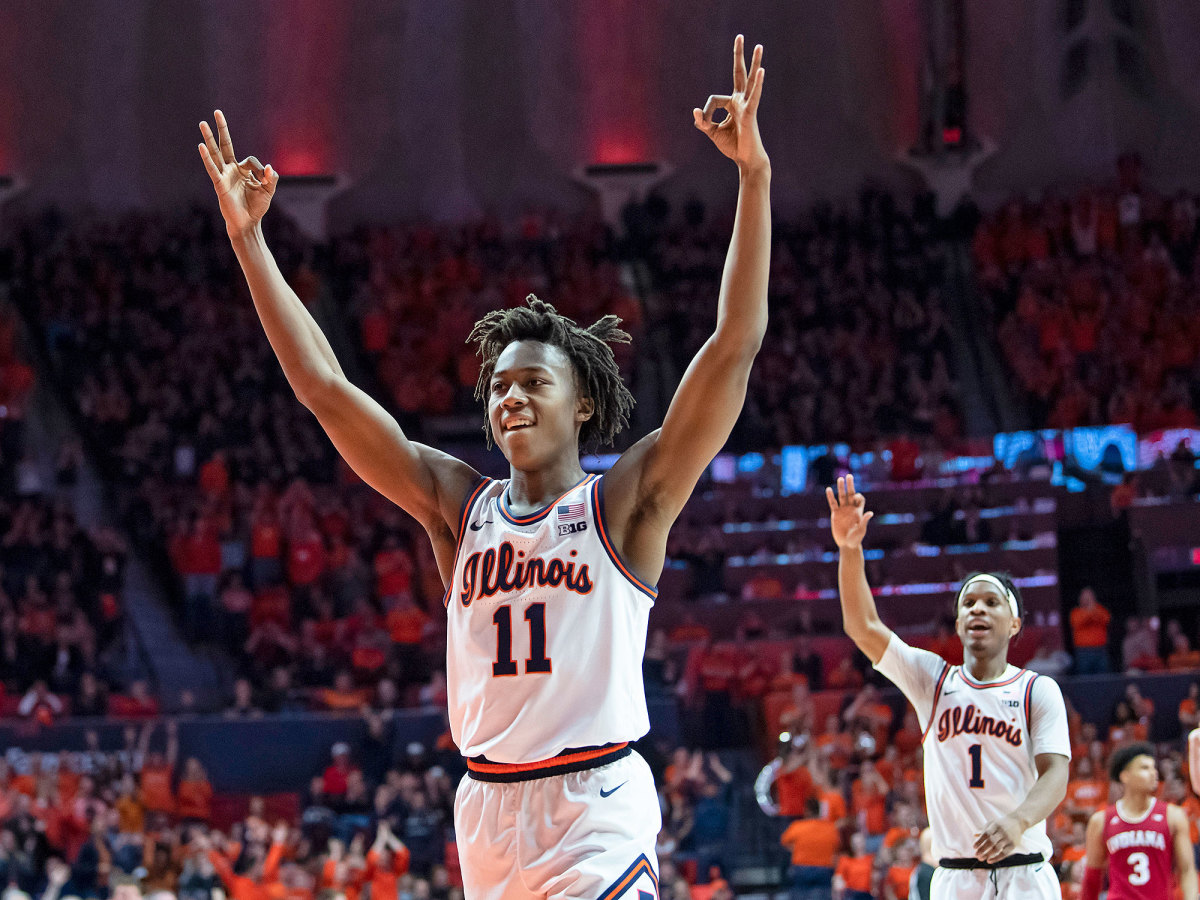Ayo Dosunmu's Moment Is Now
Ayo Dosunmu surveyed the situation in the final minute and recognized what Northwestern coach Chris Collins was throwing at him. The Wildcats were in man-to-man defense, with Anthony Gaines in front of the Illinois guard out top, some 28 feet from the basket. But when the shot clock hit 10 seconds, Northwestern quickly shifted back to the 3–2 zone look that had limited Dosunmu much of the game.
Bringing two other guards up to the wings meant the driving lines were shut down. Seemingly out of shooting range, the only real option was to pass, which is exactly what Collins wanted. He was trying to accomplish what every Big Ten coach hopes to do late in games: Get the ball out of the hands of the greatest closer in college basketball.
But there was one other option in play. Ayo Dosunmu knew it because he listened to the voices in his head—as he does constantly in the practice gym, honing his craft, building his confidence, stoking his determination. The voices that tell him what he can’t do until he shuts them up with action.

Can’t shoot from deep, the voices said.
Watch this, Dosunmu countered, and rose up from a distance normally reserved for single-syllable NBA stars Steph and Dame.
The shot splashed; the game was all but over. The closer had closed again—just four days after scoring 15 straight points to end regulation and start overtime against Nebraska, just 10 days after a triple double against Wisconsin. He’s hit so many high-pressure shots in three seasons that the Big Ten Network put together a sizzle reel of them this week and still left off some of his greatest hits.
The most 𝑪𝒍𝒖𝒕𝒄𝒉 player in College Basketball. 🔥@AyoDos_11 has delivered when it matters most his entire @IlliniMBB career. ⬇️ pic.twitter.com/w2qNxYwRQd
— Big Ten Network (@BigTenNetwork) February 17, 2021
“He’s got ‘it,’ ” says Illinois coach Brad Underwood. “I don’t know how else to describe it.”
The bomb to finish Northwestern was his second three in a span of 40 seconds, after the massive underdog Wildcats had closed within two points. Those threes raised his shooting percentage in the final 90 seconds of games (plus overtime) this season to an absurdly clutch 67%. When the last one went in, Dosunmu jogged back downcourt, chuckling directly at Northwestern’s slack-jawed bench. “There was some talking during the game, just mutual competitiveness,” Dosunmu says. “I got the last laugh.”
Ayo had launched what his father, Quam, later labeled “the super dagger” from at least 26 feet out. “Maybe 28,” Quam says. “Tomorrow I might say 30.”
He laughs.
“Next year it’ll be 32.”
That would fit because there is a folklore building around the scion of Nigerian immigrants—the workaholic product of blue-collar Chicago—the Windy City savior who traveled down I-57 to resurrect Illinois basketball and would not leave without a chance to finish the job in March. It’s all happening the way he foresaw it—the team’s ranking getting higher, the games getting bigger, the shots getting deeper and more dramatic. It’s all unfolding according to the internal dialogue in a 21-year-old’s one-track mind.

Truth be told that dialogue isn’t only internal. Not in the gym when he’s working on his game. When the voices in Ayo Dosunmu’s head tell him no, he talks back. Out loud.
“He literally talks to himself when we’re working out,” says Illinois assistant coach Ron (Chin) Coleman, who grew up playing sports with Quam at the 71st Street YMCA in Chicago. Coleman is Ayo’s personal workout Yoda, putting him through his individual paces before and after team practices. The 6' 5" junior will face off against graduate manager Kwa Jones (his “sparring partner”) while talking his way through every play.
“It can freak the managers out,” Chin says. “The good players, they all have some weird quirks about themselves, and he has a little bit of that. He is putting himself in that moment and living that moment.”
The dialogue, according to Ayo, is based on any and all shreds of disrespect that can be garnered. They are becoming increasingly rare as his star ascends, but he’ll take what he can get. Some are passed along by Quam and Chin, others by assistant Orlando Antigua. “I think Coach O makes some of it up,” Ayo says. “But he will intentionally say something to trigger me to be an animal.”
As a sophomore the book on Dosunmu was that he was “hard right”—heavily dependent on his right hand and less effective going to his left. So in workouts he says to himself, “I’m going right—oops!—crossover left. Pull up.”
After shooting 29% from three-point range last season, there were doubters about his range. “Can’t shoot,” he says to himself while launching jumpers. This season that percentage is 42.2.
When analytics showed him making fewer than 30% of his midrange shots before this season, that became the focus of the self-critique. That became the “money shot.” “Go to your money,” Chin instructs, and Ayo talks himself through it.
“If I hear a team say something during a game, I keep repeating it over and over,” he says. “I’m giving myself that extra edge, that extra motivation.”
He can be heard chattering in the gym at just about any hour—early, late, whenever. The pandemic might have curtailed the social life of most Illinois students, but it’s pretty much business as usual for Ayo. “He doesn’t party. He doesn’t hang out. He doesn’t drink. He doesn’t go to the bars,” Chin says. “He’s never been to Kam’s [the venerable Champaign bar that labels itself ‘Home of the Drinking Illini’]. He’s all the way in this deal.”
He has been for life, really. Quam remembers coaching a kindergarten team, and Ayo suiting up to play with them at age 3. That started a pattern of playing against older competition with Quam coaching many of those teams.
For 30 years, Quam worked as a UPS manager. When Ayo and his older brother Kube were in elementary school, he shifted his schedule to work with them on basketball in the afternoons—Quam would get to work at 1:30 a.m., get off in the late morning for lunch and a quick nap, then pick up the boys at 1:30 p.m. Then he would take them to his parents’ house to finish their schoolwork, and after that was basketball practice. When that was over, the family of six—mother Jamarra and two older sisters—would gather back home for dinner.
The two dominant themes in the family: work ethic and togetherness. Quam was 7 years old when his family moved to Chicago from Lagos, Nigeria. Immersed in a different culture all his parents had were 9-to-5 jobs and each other. “They didn’t know anybody here,” Quam says. “So the family structure was what we had before we expanded and got to know other people. We have kept that close-knit structure.”
Indeed the Dosunmu extended family has been an outsize presence at Ayo’s games—home and away—his entire life. That changed this season when the pandemic shut down attendance. That’s been a hard adjustment for the Dosunmus, but not one they complain about. “This is something the entire world is going through,” Quam says. “People are dying. This is something we have to do.”
To compensate, there are family Zoom calls and marathon FaceTime sessions on Sundays—sometimes up to 16 of them together at a time, trying to approximate intimacy and normalcy. And there are new postgame rituals: Ayo calls his parents when he’s finished with interviews, and after road games, Quam stays awake until Ayo notifies him that the Illini have returned safely to campus.
The postgame conversations are all joy these days. Illinois has won six straight, rising to second place in the Big Ten and No. 5 in the AP poll. And Ayo’s play keeps elevating along with the team’s, to the point where he’s now being promoted as a viable contender to Luka Garza for both Big Ten and national Player of the Year honors—awards that looked like near-locks for the Iowa big man much of the season.
Ayo is averaging 21.3 points, 6 rebounds and 5.1 assists, having become a master of pick-and-roll situations. “You put him in ball screens and situations where he can get a crease; he’s the best player in the country,” Underwood says. But the succession of big baskets at the end of close games is what differentiates him from everyone else in both the conference and the nation. Even in games where defenses are designed to limit him (like Northwestern) and games where he doesn’t play well for long stretches (Nebraska), the final minutes are different.
“It starts with not being afraid to fail, not being afraid of the moment,” Ayo says. “I want to take on that challenge. I loved Kobe Bryant’s mentality. He was never afraid of failure. He had the guts to take those shots.”
They are the moments every player relishes in pretend settings—in the backyard, in the practice gym. Not everyone has that same eagerness in reality when a game is on the line and the world is watching. Ayo does.
“His belief in himself is a testament to his work,” said Illinois strength and conditioning coach Adam Fletcher. “That leads to confidence in those moments.”
As startling as the individual plays have been—back-to-back threes to break open a tie game in an upset of Michigan State as a freshman, the buzzer-beater against Michigan as a sophomore, the Northwestern super dagger this week—the totality does not surprise the architect or his father. This was the plan all along.
“This is what he was built for,” Quam says. “This is all the stuff we envisioned. We don’t duck. We don’t hide from anything.”

The Dosunmus opened the door and welcomed in the hype on Oct. 17, 2017. At the Jordan brand store in downtown Chicago, five-star prospect Ayo walked out in front of the media gathered for his college announcement wearing an Illinois shirt, making official his commitment to the home-state school over Wake Forest.
The storied Chicago pipeline downstate to Champaign had become rusted and leaky in preceding years. Jalen Brunson wound up winning national titles at Villanova. Cliff Alexander chose Kansas. The highly rated players from the city who did wind up wearing blue and orange couldn’t pull the program out of a lingering malaise.
Dosunmu not only committed to trying, he committed to succeeding. He welcomed the expectations, saying he wanted to lead Illinois back to the NCAA tournament for the first time since 2013. The hope grew that he would be this generation’s Dee Brown, the prized Chicago recruit who helped take the Illini to a 35–2 season and the 2005 national title game before falling to North Carolina.
For Underwood who was 14–18 in his debut season after coming from Oklahoma State, signing Ayo was his first big victory. “We were trying to sell a dream, what this program could be,” he says. “To get somebody to believe in that dream was very important. This is a young man with tremendous pride in his home state, and staying home meant a lot to him.”
Playing within driving range for his family was important. Playing for Chin Coleman was important. Playing for Illinois was important.
But when Ayo arrived fresh off a USA Basketball stint in the summer of 2018, he was “overtrained,” according to Fletcher, and broken down. He had weak ankles, weighed just 170 pounds and couldn’t bench press 185 pounds once.
Today he’s 208 pounds and can bench 185 (the standard NBA combine testing weight) 18 times. His vertical leap has improved 11 inches. Along with everything else, he committed to the weight room—not just the weights themselves but the bonding that can happen there.
“It’s fun to think back to when I first got him,” says Fletcher. “What he’s done physically but even more with his leadership, what he’s done to gather the group emotionally.”
Like many modern strength coaches, Fletcher’s job also includes conditioning the minds of players. In Ayo he found someone hungering to not just be great but to lead a team to greatness.
He became the first freshman in Illinois history to lead the team in scoring, but the Illini went 12–21. For his sophomore season, Ayo wanted to do more individually and collectively. During recovery massages and other conversations, Ayo tapped into Fletcher’s team-building ideas—demanding of teammates but not being “a tyrant,” as Ayo put it.
“He started taking guys out to lunch,” Fletcher says. “He learned about their families, who they are as a person. Get in a different car each time you go to the facility. He’s become one of the best leaders in the country, the best I’ve been around.”
The progress year-over-year was significant: Last season, Illinois broke through, going 21–10 and 13–7 in the Big Ten. The Illini sprinted into the postseason having won five of their last six. Dosunmu was a star. The only thing that remained in fulfilling his collegiate prophecy was an NCAA tourney run—and then the sport was abruptly shut down.
“It was heartbreaking,” says Quam. “It’s like playing poker and you know you’ve got a hand that beats everything. And then you don’t get to play it.”
Last spring it looked like Ayo Dosunmu’s college career had ended without a proper ending. Nobody was surprised when he put his name in the NBA draft in April, and nobody would have held it against him if he stayed in it.
But Ayo kept showing up on the Illinois team Zoom calls. He never disengaged. And one night in July just minutes before putting out a video announcing that he would come back for his junior season, Ayo called Underwood to inform him.
“I was sitting on my back deck having a glass of wine,” Underwood says. “I did backflips down the street, then had another glass of wine. It was a very good evening.”
Like every standout college player, Ayo’s ultimate goal is the NBA. But unlike every standout college player, he genuinely wanted to experience the best part of his current level—the NCAA tournament. He remembers watching Kemba Walker leading Connecticut to the 2011 title; Michigan guard Trey Burke’s bomb to tie Kansas on the way to the 2013 Final Four; Carsen Edwards nearly carrying Purdue to that level in 2019. He wanted that shot at One Shining Moment.
“I remember the chills I had watching those games,” Ayo says. “It’s a tradition I wanted to be a part of. I want the great commentators commenting on my game. I want to experience it all in basketball.”
The opportunity awaits, floating out there on the horizon, tantalizingly close now. March is coming. Illinois is soaring. Ayo Dosunmu, the greatest closer in the college game, is ready for his closing act.
